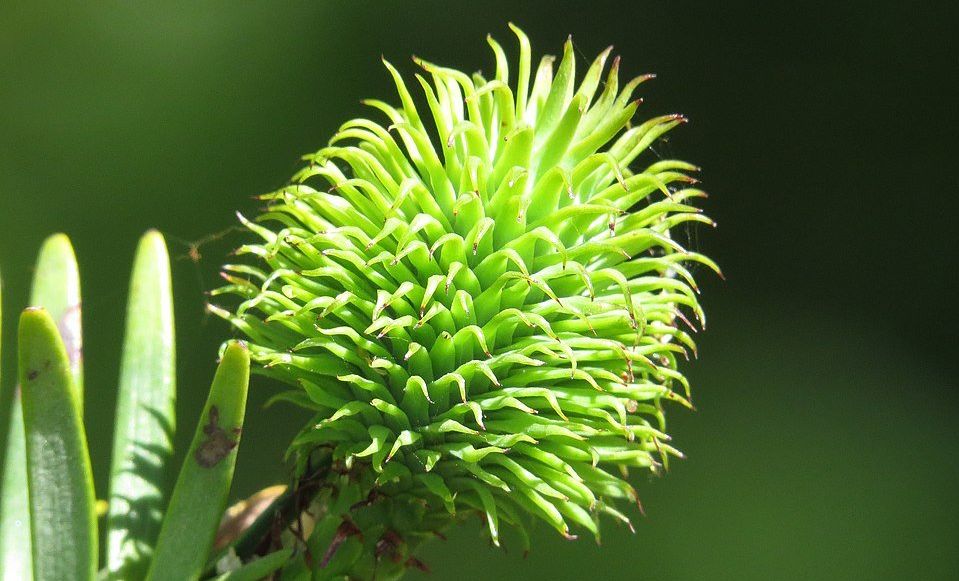Couple plants real-life 'money tree' and its first seeds are worth over $6,700
The species is at least 200 million years old.
A Wollemi pine and one of its cones.
As the old adage goes, money doesn’t grow on trees. However, what if you had a tree that was so rare that people would spend good money for its seeds? Then you could honestly say that you have a money tree growing in your yard. Such is the case for a retired couple in England, Pamela and Alistair Thompson, both 75, who in 2010 paid £70 ($98) for a 46cm-tall Wollemi pine sapling that a friend bought on the Shopping Channel. It’s believed that it was the first ever endangered tree species to be protected by making it available to the general public.
What is the Wollemi pine?
The Wollemi pine is valuable because it appears in the fossil record as far back as 200 million years ago and was thought to have gone extinct about 70 to 90 million years back. However, in 1994, a bushwalker in Australia came across a Wollemi pine in a secluded gorge. Biologically, it was a discovery as significant as coming across a living dinosaur in a hidden part of Australia in the ‘90s.
Wollemi is an Australian Aboriginal word that means "watch out—look around you."

The tree may have made its way to Eurpoe, but the wild trees are under threat from wildfires and climate change. It’s believed that only about 90 exist in the wild today. In 2006, it made its European debut when Sir David Attenborough planted one at the Royal Botanic Gardens in Kew. “How exciting we should discover this rare survivor from such an ancient past,” Attenborough said.
After 15 years of special care, the Thompson’s tree began to bear fruit for the first time in August 2025. “This year has been so unusually dry, it happened earlier,” she said, according to The Times. The couple now plans to package the valuable seeds from the tree and give the money to the National Garden Scheme. The National Garden Scheme is a government program where people open their gardens up to the general public, and the money that is generated is donated to the Queen’s Nursing Institute.
- YouTube www.youtube.com
How much does a Wollemi pine cost?
“I saw a small tree for sale for more than £1,000 ($1352), which shows how rare they are. We’re planning to package the seeds five or six at a time and sell the bundles online for £5 ($6.76). We’ve seen some retailers sell them for much more, but we want to make them accessible for people, as well as raise money for charity. We don’t yet know how many will be healthy and produce trees. Only time will tell.”
"We have around five large cones, which have produced about a hundred or so large seeds each. It would be lovely to see just how many seeds we can produce, but I have been very surprised by the numbers so far this year,” she said, according to Unilad. So, if you do the math, 100 seed packs at $6.76 each would go for $676. Not bad for just collecting seeds.
But they could make a lot more money off the seeds if they chose to do so. It’s believed that one seed can go for as much as £10 ($13.52). If they sold all 500 seeds produced by the five cones, they'd make $6,760.
This tree could net them thousands of dollars a year in perpetuity. “It really does prove that money can grow on trees,” Mr. Thompson said, according to The Times.

Preserving the Wollemi pine for the future
In 2023, over 170 young Wollemi pines grown by the Botanic Gardens of Sydney, in Australia, were shipped to be planted in 28 botanic gardens with climates that could support the pines, across the UK and Europe. One Wollemi was sent to Atlanta, Georgia, in the U.S.
“Discovering the lost Wollemi pines in the wild was a truly astounding moment for international tree conservation, and to be a leading partner nearly thirty years later in launching this important new metacollection on UK soil is an exciting moment for Forestry England,” Mike Seddon, Forestry England Chief Executive, said in a press release. “As we care for the Wollemi pines we plant today, we’ll be able to study the way they grow, learning with the other botanic gardens how they flourish outside Australia. The climate crisis means that across all continents, many trees like Wollemi pines are facing urgent threats to their survival. We know that 34 per cent of conifers are now endangered, and our ongoing work to research, propagate, and save tree species is more vital than ever.”
